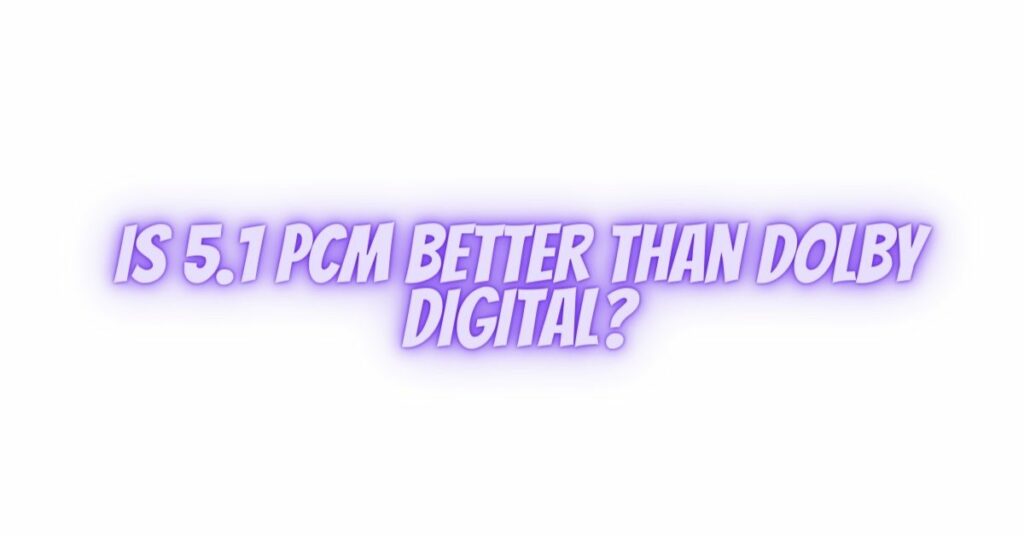When it comes to home theater and audio experiences, the choice of audio format can significantly impact the quality of sound you enjoy. Two popular options for surround sound are 5.1 PCM (Pulse Code Modulation) and Dolby Digital (often referred to as AC-3). In this comprehensive article, we’ll explore the characteristics of both audio formats and help you determine whether 5.1 PCM is better than Dolby Digital for your specific audio needs.
Understanding 5.1 PCM
5.1 PCM, also known as 5.1 Linear Pulse Code Modulation, is a multi-channel audio format used to deliver surround sound. It is characterized by its uncompressed audio representation, capturing audio signals without any data loss. The “5.1” in its name refers to the five primary channels (front left, front center, front right, rear left, and rear right) and one subwoofer (the “.1” channel) used in a typical 5.1 audio setup.
Understanding Dolby Digital
Dolby Digital, or AC-3 (Audio Coding 3), is a widely adopted audio compression format. It is known for its presence in DVDs, Blu-rays, streaming content, and broadcast television. Dolby Digital employs lossy compression, meaning it reduces file sizes by discarding some audio data, but it does so intelligently to maintain high audio quality.
Comparing 5.1 PCM and Dolby Digital
- Audio Quality:
- 5.1 PCM: Uncompressed audio inherently offers the highest quality. It captures the full depth and clarity of sound, making it an excellent choice for audiophiles and those with high-end audio systems.
- Dolby Digital: While Dolby Digital uses lossy compression, it is designed to maintain audio quality effectively. It provides an excellent compromise between audio quality and file size, suitable for a wide range of applications.
- Bitrate:
- 5.1 PCM: The bitrate for 5.1 PCM is notably high, as it does not employ compression. This results in a larger file size compared to compressed formats.
- Dolby Digital: Dolby Digital uses efficient compression techniques, resulting in lower bitrates and more manageable file sizes. This makes it suitable for streaming and media distribution.
- Compatibility:
- 5.1 PCM: 5.1 PCM is compatible with most audio and video playback devices, but it may require more storage space and bandwidth due to its larger file size.
- Dolby Digital: Dolby Digital is widely supported and compatible with a broad range of audio and video playback devices, making it a practical choice for various media.
- Dynamic Range:
- 5.1 PCM: 5.1 PCM provides a wide dynamic range, ensuring both soft and loud sounds are faithfully reproduced.
- Dolby Digital: Dolby Digital also supports an ample dynamic range, preserving audio dynamics effectively.
- Surround Sound Experience:
- 5.1 PCM: With its uncompressed nature, 5.1 PCM can provide a more immersive and precise surround sound experience, especially on high-end audio systems.
- Dolby Digital: Dolby Digital is known for delivering an immersive surround sound experience, making it suitable for cinematic and home theater applications.
- File Size and Streaming:
- 5.1 PCM: Due to its large file size, 5.1 PCM is not commonly used for streaming but is more common in physical media like Blu-rays.
- Dolby Digital: Dolby Digital’s efficient compression makes it an ideal choice for streaming and online content distribution.
Choosing Between 5.1 PCM and Dolby Digital
Choosing between 5.1 PCM and Dolby Digital depends on your specific needs and preferences:
- If you have a high-end audio system and prioritize audio quality, 5.1 PCM may be the better choice for an immersive audio experience.
- For compatibility, streaming, and practicality, Dolby Digital is an excellent option, offering a balance between audio quality and file size.
- Your choice should also consider the source of the content, your playback devices, and the context in which you plan to enjoy the audio.
In conclusion, while 5.1 PCM offers superior audio quality due to its uncompressed nature, Dolby Digital remains a practical and widely supported format that delivers impressive surround sound experiences. The choice between these formats ultimately depends on your specific audio needs and the equipment at your disposal.


